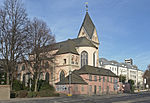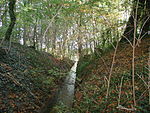Tauzieher
Limestone sculpturesMonuments and memorials in CologneOutdoor sculptures in GermanySculptures of men in GermanyStatues in Germany

The Tauzieher (German for "rope puller") is a limestone sculpture by Nikolaus Friedrich which was erected in 1911 in Rheinauhafen, Cologne. It depicts a man making a heavy rope or hawser fast to a bollard and is 6.5 metres (21 feet) in height. In 1980, it was listed as one of the first heritage sites in Cologne.
Excerpt from the Wikipedia article Tauzieher (License: CC BY-SA 3.0, Authors, Images).Tauzieher
Drehbrücke, Cologne Altstadt-Süd (Innenstadt)
Geographical coordinates (GPS) Address External links Nearby Places Show on map
Geographical coordinates (GPS)
| Latitude | Longitude |
|---|---|
| N 50.93209 ° | E 6.963274 ° |
Address
Der Tauzieher
Drehbrücke
Cologne, Altstadt-Süd (Innenstadt)
North Rhine-Westphalia, Germany
Open on Google Maps










